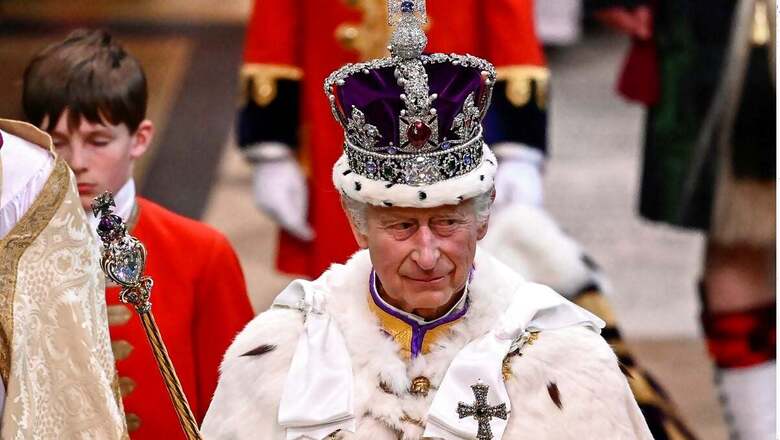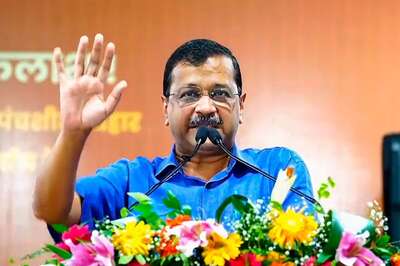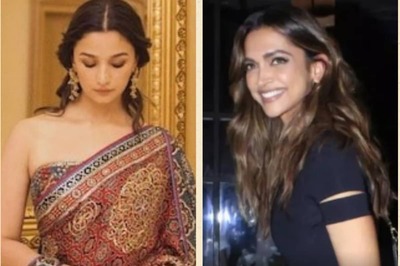
views
The second and concluding part of the article focuses on how an interesting principle associated with the British monarchy “His Majesty’s Loyal Opposition” actually fostered the growth of civilian politics in colonial India.
Recently, King Charles III was coroneted at Westminster Abbey, in the United Kingdom. He has a Hindu Prime Minister of Indian origin at the head of the Cabinet. India, the “Jewel in the Crown”, was the largest colony the British Empire ever had. India, as a nation, waged a long freedom struggle against British rule to attain Independence. However, a closer look at the freedom struggle would reveal that it advanced more through association with the British rule, and less through dissociation.
This is an interesting outcome of the principle of “His Majesty’s Loyal Opposition.” We have seen, in the first part, how this concept saved the British monarchy from being swept away by revolutions or subsumed by the Parliamentary democracy. In the second and concluding part, we shall see how the same concept fostered the growth of civilian politics in colonial India.
Admittedly, monarchy was not the most appealing British political institution for the Indians. It was the House of Commons. Mirza Abu Taleb Khan (1752-1806), originally of Turkish ancestry, was the first Indian to have witnessed the proceedings of the British Parliament extensively (circa 1800 AD). It was, however, Raja Ram Mohun Roy (1772-1833) who sat through the passage of Representation of the People Bill, 1831 (Reform Bill, 1831) in the Commons, and submitted his proposals for judicial, administrative and revenue reforms before the Select Committee of British Parliament. There was recurrent advocacy in the 19th century for nominating Indian members to the British Parliament. Hurrish Chunder Mookerji (1824-1861), the editor of Hindu Patriot, rejected the suggestion of sending Indian members to the British Parliament as impractical. He advocated a radical solution of “Parliament in each of the presidencies of India” in the 1850s.
The British rule in India began as a ‘corporate government’, by the East India Company, rather than imperial rule. Whatever the British rule might be at home, in India, it was seen as a liberator from personal rules of potentates.
“What all its faults and failures,” says Bipin Chandra Pal, “the administration of East India initiated a line of progress which helped replace the personal rule, whether Hindu or Muslim princes, by a new reign of law” (Beginnings of Freedom Movement in Modern India, P.1). Indian connection with British monarchy was understandably tenuous. The emotional connect with the House of Commons was much stronger.
House of Commons in London inspired generations of Indians as an exemplar. It had intervened quite early, to check the abuse of power by East India Company’s employees. The Regulating Act, 1773 set up an embryonic legislature and Supreme Court of Judicature. Indians saw the potential in the legislative council to expand into Parliament in India. The periodical constitutional reviews and reforms carried out by the British only fed that ambition. Indian Councils Act, 1861, allowed the entry of Indians into the councils. The statute was promulgated, following the takeover of Indian administration by the Crown, in the aftermath of the 1857 Uprising. In 1877, Queen Victoria, fashioned herself as Queen-Empress of India, which, though a queer term in British politics, attached itself to British monarchs until George VI as “King Emperor” of India. While the British monarchy itself did not interest the Indians much (though politicians like Dadabhai Naoroji was very fond of citing the Queen’s Proclamation, 1858), the entire period of India remaining a Crown colony was marked by a growth of constitutionalism and mass movements.
Interestingly, these movements were fairly tolerated, and not dealt with in a manner as the revolutionary movements. In his Presidential Speech at Calcutta Congress (1886), Dadabhai Naoroji asked whether it was possible to have such a gathering under any Hindu monarch or Muslim monarch though they were as tolerant as Vikramaditya and Akbar. “It is only under the civilizing rule of the Queen and people of England” added Dadabhai, “that we meet here together, hindered by none, and are freely allowed to speak our minds without least fear and without least hesitation” (Speeches and Writings of Dadabhai Naoroji, P.3).
While modern-day nationalists might snigger at the term “civilizing influences” of England, few could deny that freedom of political speech and expression had a bull run under British rule (unless the participants were speaking of disestablishing British Empire by force). While the police force had to be regularly deployed (for safety of both parties) wherever Swami Dayanand disputed the Vedas with Sanatanit pundits, police personnel were never found necessary in political meetings criticizing British policies. Most public meetings in the 19th century began with an assertion of loyalty to the British crown and ended up by peeling the skin of British policies. Yet, they were tolerated in the spirit of “Her Majesty’s Loyal Opposition”. Thus, while the British sought to control vernacular newspapers through law, there was no law to curb free speech at public meetings until the Seditious Meetings Act, 1907 (even which was rarely invoked). Even Tilak was charged with sedition for his article in Kesari, as it coincided with the assassination of W.C. Rand by Chapekar brothers (1897). Had no assassination taken place, Tilak would perhaps have been left unmolested, despite his strident strand during Famine Relief Campaign and Plague Relief Campaign.
Throughout the Victorian and Edwardian era, the Indian constitutionalist movement continued to grow. A Surendranath Banerjea, Pherozeshah Mehta, Lala Lajpat Rai or Gopal Krishna Gokhale could get audiences not only in India but also in Britain. At a distance of time, Indians tend to underestimate the role of those ‘petitioners’, in the achievement of India’s independence. We should actually see their contribution towards the establishment of constitutional government and democracy in India. India could not have been world’s largest democracy without these pioneers. Frankly, they benefited from the theory of “His Majesty’s Loyal Opposition”, which did not equate critics with enemies. This view forms the cornerstone of democracy as well.
Loyalty towards the Crown, on part of colonial Indian leadership, might appear disgraceful to the generation born in free India. It is not only because India is an independent nation today, but is also modern democratic republic. We tend to take certain things for granted as though they had always been there. However, things were very different in the 19th century. First, there was a valid fear of India relapsing into the later-Mughal era anarchy, and a kettle of vultures from Central Asia feasting on it, if the British connection was suddenly lost. Secondly, the British rule offered scope for institutional development towards the representative government in India, not visible under the previous Mughal or Maratha rulers. The pioneers of constitutional agitation in India were seized of these basic facts, which explained their fundamental loyalty towards the British. Their loyalty served a practical purpose, and should not be confused with toadyism. They were not afraid of telling the truth to power, a state from which Indians started retracting after independence.
The practitioners of constitutional agitation planned to take a different route to independence. They advocated India gaining self-government gradually through a series of political reforms. “We Indians have been free British citizens as our birthright”, observed Dadabhai Naoroji (1906), “as if born and living in England from the moment we came under British Flag.” Dadabhai cited his own example that he could vote and contest election in Britain by virtue of being from India, a Crown colony. Dadabhai’s phrase later lent the title to the tract published by V.S. Srinivas Sastri, Self-Government for India under the British Flag (1916). Sastri envisaged India assuming a status of dominion within the British Empire comparable to Canada, Australia, New Zealand, South Africa etc. Even Tilak’s Home Rule campaign during World War I was legalistically for Dominion Status.
This balloon of Dominion Status, or Commonwealth of Nations, was punctured by Jawaharlal Nehru in a well-reasoned speech at All-Parties’ Conference in Lucknow on August 29, 1928. He asked whether, on obtaining Dominion Status, India would be promoted from the exploited part to that of the exploiting part of the Empire. Whether India, as a self-governing Dominion, would join Britain to exploit and subdue Egypt or Africa. This was the first definite breach of loyalty towards British Empire. The ideal of Dominion Status advocated by Pt. Motilal Nehru (in Nehru Report, 1928) was junked within a year by his son Jawaharlal Nehru. Nehru Jr., in his Presidential Address at Lahore (1929), advocated Purna Swaraj or complete independence as the creed of the Congress. In hindsight, it now became evident that Swaraj, which Mahatma Gandhi advocated since 1921, was only Dominion Status.
Though Purna Swaraj, or independence, was unequivocally recognised as the goal of freedom movement, there was no linear progression towards that ideal. The principle of “His Majesty’s Loyal Opposition” reinvented itself in an era of councils with ‘unofficial majority’. Indians had to play the game according to rules of the game set by British until the nation came out like a butterfly out of the cocoon in 1947. This meant that despite launching the Civil Disobedience Movement (1930), and sustaining it for a few years, the Congress had to reenter the councils as it had done in 1923 in the aftermath of the Non Cooperation Movement. Congressman Asaf Ali, in a newspaper article “Why the Legislatures Must be Captured” (1934), argued that the Congress could ill-afford to boycott the councils for long without undermining its own credibility as a people’s party. Since Congress’ boycott of councils would not prevent private individuals to contest the elections, and there would be as many voices in the legislature as there are members, which would immensely damage cause of independence. The Congress contested the elections under Government of India Act, 1935 in 1937 and 1946. The 1946 interim elections indirectly led to the formation of Constituent Assembly (1946-1949), which drew up the Constitution of India.
India’s freedom movement advanced more by engaging with the British rule than by shrinking from it. Dissociations and insurrections were episodic, whereas engagement was constant. Any revolutionary alternative to independence would have more disruptive, damaging and costly to normal and national life. Independence actually came by means of political reforms envisaged by the pioneers of constitutional agitation, way back in the 19th century. Whereas revolutionary activities doubtless had a role in advancing national life, it was more at the level of emotions rather than actual political progress. Revolutionaries inspired a sense of patriotism, and self-sacrifice, necessary for devotion to and self-respect of the nation. They, however, were not interested in the form of government that independent India would have. This was, however, a very important question to the “loyal” constitutionalists.
In the public imagination, we could have no better image of Britain as a colonising and exploiting power. That is not actually the whole truth, if one looks at the political evolution achieved during the era. “In truth”, proclaimed George V (1919), “desire after political responsibility has its source at the root of the British connexion with India. It has sprung inevitably from the deeper and wider studies of human thought and history which that connection has opened to the Indian people. Without it, the work of the British in India would have been incomplete.” It reveals that a British monarch was actuated by more honourable sentiments towards India’s destiny than merely preserving the “Jewel in the Crown” colony for the benefit of his descendants.
On November 12, 1930, George V inaugurated the First Round Table Conference in London, to discuss the blueprint of constitutional reforms in India. The Congress, being in the midst of Civil Disobedience Movement, was neither invited nor participated, but there were many other important personalities and princes who attended. Mahatma Gandhi participated in the Second Round Table Conference (1931), as the sole delegate of the Congress. The Round Table Conferences, through the White Paper (1934), led to the promulgation of the Government of India Act, 1935 (the longest statute passed by the British Parliament till then).
It is thus evident that while the British might have heavily put down revolution and insurrection, they tolerated the civilian politicians notwithstanding their criticism of the British rule and advocating India’s independence. The idea of political evolution in India was not foreign to the British rule. This would never have been possible without the concept of “His Majesty’s Loyal Opposition.”
The writer is author of the book “The Microphone Men: How Orators Created a Modern India” (2019) and an independent researcher based in New Delhi. The views expressed in this article are those of the author and do not represent the stand of this publication.




















Comments
0 comment